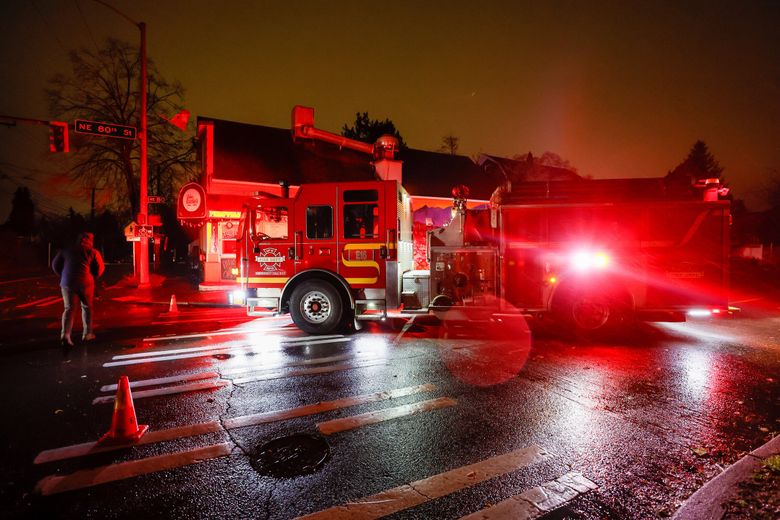Bomb cyclone: Over 641,000 people without power in Western Washington
Nov. 19, 2024 at 9:21 pm

A firetruck blocks Northeast 80th Street at Roosevelt after power lines fell across the street Tuesday, Nov. 19 in Seattle. (Jennifer Buchanan / The Seattle Times)
By
Paige Cornwell
Seattle Times staff reporter
At least 641,000 customers throughout Western Washington were without power as of 10:20 p.m. Tuesday as the region got walloped with heavy rain, snow and ripping winds.
That included nearly 411,900 Puget Sound Energy customers who lost power, and the utility is asking customers to continue reporting outages so they can be reported into the system, spokesperson Andrew Padula said.
Related Bomb cyclone
In Seattle, 112,672 customers were without power, according to Seattle City Light
The Snohomish County Public Utility District reported power outages affecting 115,200 customers.
Outages maps for PSE and Snohomish PUD were down down for a period Tuesday evening but were back online. Seattle City Light was working on “troubleshooting” an issue that was causing problems for people reporting outages in the city.
Other smaller utilities in Western Washington also reported at least 15,000 more outages caused by high winds and downed wires.
For those who are in the dark, there are a few things you can do to stay safe during outages:
Use a generator safelyThose who own power generators may want to start running them immediately. But it’s essential to make sure they are at least 20 feet away from your home, and in a dry and well-ventilated space.
Generators should be kept outdoors, but they must be protected from rain or flooding. (Having a cover should help.) Otherwise, you risk electric shock.
Homeowners should also use a heavy-duty extension cord to connect appliances to a generator. It is dangerous to connect a generator to household wiring without a transfer switch, Seattle City Light says. Doing so can cause electrical energy from the house to flow back to the utility wires, putting electrical crews in danger. The generator could also explode or catch fire.
During an outage, it’s also a good idea to unplug appliances and electronics not in use, to protect them from a power surge once electricity comes back on.
Avoid using candles for light, as they present a fire risk. Opt for battery-operated flashlights or lanterns.
Each home should also be equipped with a battery-operated carbon monoxide detector. The gas is colorless and odorless.
Preserve food
Food can quickly spoil in the heat, so it’s important to stock up on nonperishable items such as boxed or canned food (and don’t forget to keep a manual can opener on hand).
Refrigerated food can stay cold for about four hours after power is lost. Foods in a full freezer can last for up to two days, according to the Federal Emergency Management Agency. Half-full freezers keep the food cold only for 24 hours.
Keep refrigerator doors closed as much as possible to keep the food cold. Coolers can also help, but make sure there’s enough ice and cold packs to keep them below 40 degrees.
Stay connected
Try to limit cellphone and mobile device usage to preserve battery power. Place phones on power-saving mode or dim the screen brightness. Some companies also sell solar-powered phone chargers. If you want to charge your phone in your car, do so outside and not in a garage or closed space, where running the vehicle can lead to carbon monoxide poisoning.
For more tips about how to keep yourself safe during a power outage, visit the Federal Emergency Management Agency’s website.
Material from The Seattle Times archives is included in this report.
Paige Cornwell: 206-464-2530 or pcornwell@seattletimes.com.
seattletimes.com
My comments:
We just set a new record low pressure record.
And Bomb Cyclone II is on it's way again!
Not going away yet.
Eric |





